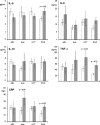Genes of intestinal Escherichia coli and their relation to the inflammatory activity in patients with ulcerative colitis and Crohn's disease
- PMID: 21877213
- PMCID: PMC3189319
- DOI: 10.1007/s12223-011-0051-z
Genes of intestinal Escherichia coli and their relation to the inflammatory activity in patients with ulcerative colitis and Crohn's disease
Abstract
Escherichia coli gene fimA was the most frequent gene that occurred in the intestine of all investigated groups. All subjects with fimA gene had significantly higher values of tumor necrosis factor alpha (TNF-α) and CRP than those with other E. coli genes. There was also a tendency to increased serum interleukin (IL)-6 levels in patients carrying the fimA gene; however, no relation was observed to serum IL-8 and IL-10. Patients with Crohn's disease had significantly higher IL-6 than those with ulcerative colitis (UC) and controls. The highest levels of TNF-α were detected in the UC group. There were no significant differences in serum IL-8 and IL-10 between all three groups. The presence of E. coli gene fimA in the large bowel of patients with IBD is related to the immunological activity of the disease which may be important from the aspect of therapeutical strategy.
Figures
Similar articles
-
Characterization of adherent-invasive Escherichia coli isolated from pediatric patients with inflammatory bowel disease.Inflamm Bowel Dis. 2012 May;18(5):913-24. doi: 10.1002/ibd.21899. Epub 2011 Oct 12. Inflamm Bowel Dis. 2012. PMID: 21994005
-
Macrophages from IBD patients exhibit defective tumour necrosis factor-α secretion but otherwise normal or augmented pro-inflammatory responses to infection.Immunobiology. 2011 Aug;216(8):961-70. doi: 10.1016/j.imbio.2011.01.002. Epub 2011 Jan 12. Immunobiology. 2011. PMID: 21269730
-
Persistent infection with Crohn's disease-associated adherent-invasive Escherichia coli leads to chronic inflammation and intestinal fibrosis.Nat Commun. 2013;4:1957. doi: 10.1038/ncomms2957. Nat Commun. 2013. PMID: 23748852 Free PMC article.
-
Prevalence of the pathobiont adherent-invasive Escherichia coli and inflammatory bowel disease: a systematic review and meta-analysis.J Gastroenterol Hepatol. 2021 Apr;36(4):852-863. doi: 10.1111/jgh.15260. Epub 2020 Sep 28. J Gastroenterol Hepatol. 2021. PMID: 32929762
-
Heme Oxygenase-1 as a Modulator of Intestinal Inflammation Development and Progression.Front Immunol. 2018 Sep 12;9:1956. doi: 10.3389/fimmu.2018.01956. eCollection 2018. Front Immunol. 2018. PMID: 30258436 Free PMC article. Review.
Cited by
-
Escherichia coli in chronic inflammatory bowel diseases: An update on adherent invasive Escherichia coli pathogenicity.World J Gastrointest Pathophysiol. 2014 Aug 15;5(3):213-27. doi: 10.4291/wjgp.v5.i3.213. World J Gastrointest Pathophysiol. 2014. PMID: 25133024 Free PMC article. Review.
-
Estrogen inhibits the overgrowth of Escherichia coli in the rat intestine under simulated microgravity.Mol Med Rep. 2018 Feb;17(2):2313-2320. doi: 10.3892/mmr.2017.8109. Epub 2017 Nov 20. Mol Med Rep. 2018. PMID: 29207065 Free PMC article.
-
Systematic Investigation of the Efficacy of Sinitang Decoction Against Ulcerative Colitis.Front Pharmacol. 2020 Aug 31;11:1337. doi: 10.3389/fphar.2020.01337. eCollection 2020. Front Pharmacol. 2020. PMID: 32982747 Free PMC article.
-
Dynamics of predominant microbiota in the human gastrointestinal tract and change in luminal enzymes and immunoglobulin profile during high-altitude adaptation.Folia Microbiol (Praha). 2013 Nov;58(6):523-8. doi: 10.1007/s12223-013-0241-y. Epub 2013 Mar 28. Folia Microbiol (Praha). 2013. PMID: 23536261
-
Investigation of adherent-invasive E. coli in patients with Crohn's disease.Med J Islam Repub Iran. 2018 Feb 11;32:11. doi: 10.14196/mjiri.32.11. eCollection 2018. Med J Islam Repub Iran. 2018. PMID: 30159262 Free PMC article.
References
-
- Best WR, Becktel JM, Singleton JW, et al. Development of a Crohn’s disease activity index. National Cooperative Crohn’s Disease Study. Gastroenterology. 1976;70:439–444. - PubMed
-
- Chamberli WM, Naser SA. Integrating theories of the etiology of Crohn’s disease: questioning the hypotheses. Med Sci Monit. 2006;12:27–33. - PubMed
MeSH terms
Substances
LinkOut - more resources
Full Text Sources
Medical
Research Materials
Miscellaneous


